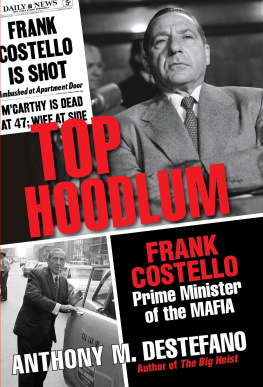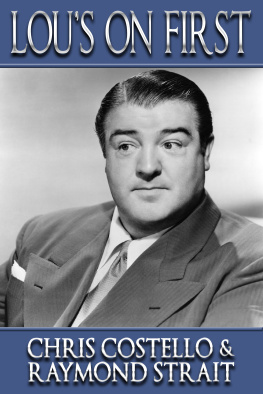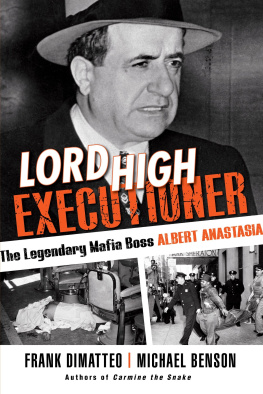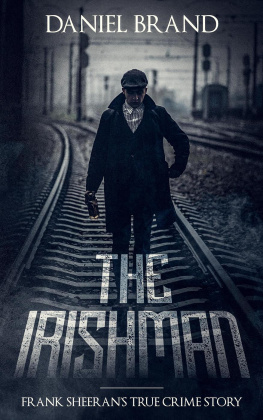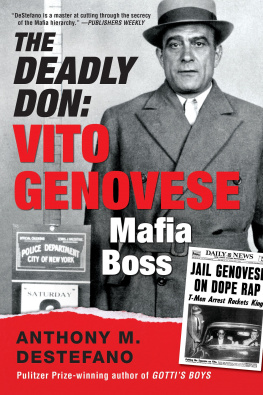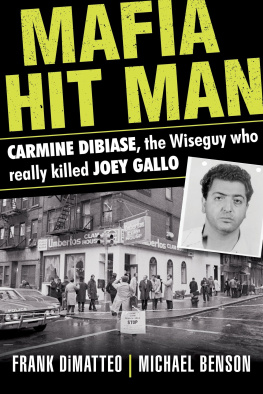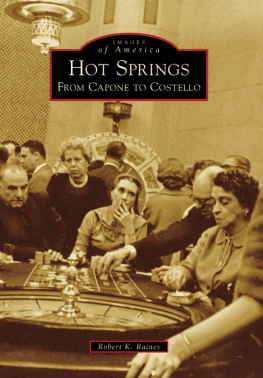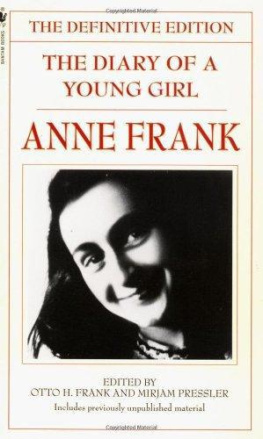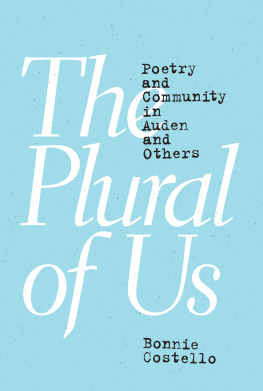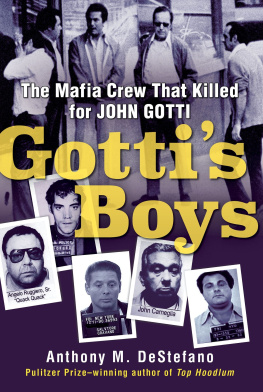ACKNOWLEDGMENTS
Writing and researching Top Hoodlum was a gigantic project, spanning many decades of the history of New Yorks organized crime scene. But luckily I had some important assistance. The first to get the nod of thanks is Noel Castiglia, who is Frank Costellos first cousin, twice removed. Noel has been an amazing student of Costellos family history as a member of the Castiglia clan and was generous in sharing with me documents and photographs that had until now been part of his private archives. By talking to members on the Castiglia family tree, Noel was able to resurrect long forgotten stories which he shared with me.
Another Costello fan who gets my thanks is Casey McBride, who curates the Facebook page Uncle Franks Place. Caseys lively page is dedicated to the history of Frank Costello and is a font of information and interesting photographs, some of which he helped secure for use in this book.
Nick Pileggi gets my thanks for suggesting the idea of a book about Costello and giving me the impetus to take on the project. Editor Gary Goldstein and my agent, Jill Marsal, did much to help.
The Brocato family, notably Joseph D. Brocato and Robert Maestri Brocato get my thanks for allowing use of a historic picture taken in New Orleans of their grandfather with Costello and his wife.
Two sources of information referred to me by Noel Castiglia Tom Cognato and Robert Goldenprovided additional interesting materials as well.
Alexandra Mosca of New York and Rossana Del Zio of Rome, Italy, get a special mention for the expertise they provided. Alexandra imparted to me critical knowledge of New York cemeteries and their architecture, and was able to locate various graves. Rossano, an accomplished expert on Italian cuisine as well as organized crime, provided perspective on nineteenth century Italy and the rise of the brigands. Margaret Stacey had nice recollections of Costello from when she was a young girl.
Kevin Reilly, Carey Stumm, and Tom McAnear at the National Archives and Records Administration helped me retrieve files and information about Costello from government records.
Cindy Miller provided help with her recollections of the night Costello was shot and her friendship with him and his wife Loretta. Joel Winograd, a noted criminal defense attorney in New York, also gets my thanks. Posthumous mention has to be made of Frank Bari, an attorney who was the grandson of the late gangster and Costello friend Anthony Carfano, who over the years told me stories about Costello.
Assistance was also provided by the staffs of the New York Municipal Archives, The Historic New Orleans Collection and The University of Texas at Austin. Thanks also to author J. P. Andrieux of Canada and former Daily News writer William Sherman.
At Newsday , assistant managing editor Mary Ann Skinner not only helped get approval for me to do this book but also toiled diligently to find old photographs taken of Costello in 1950. Laura Mann of the Newsday library found the negatives and provided me with the necessary help in getting permission to use the images.
ALSO BY ANTHONY M. DESTEFANO
Top Hoodlum:
Frank Costello, Prime Minister of the Mafia
The Big Heist:
The Real Story of the Lufthansa Heist, the Mafia, and Murder
Mob Killer:
The Bloody Rampage of Charles Carneglia, Mafia Hit Man
The King of the Godfathers:
Joseph Massino and the Fall of the Bonanno Crime Family
EPILOGUE
T HE WAKE FOR F RANK C OSTELLO was a low-key affair at the Frank E. Campbell funeral home on Madison Avenue. Reporters were allowed inside the Williamsburg Room but were asked not to approach any of the mourners, who didnt show up in great numbers anyway. Loretta sat quietly during visitation with a lady friend. Nearby were her brother Dudley Geigerman and Philip Kennedy, the modeling agency executive who was with Costello the night he was shot by Vincent Gigante in 1957. A priest was also around and talked with some of the assembled.
Costello lay in an open walnut casket, dressed in a dark blue business suit. Loretta had apparently put out the word that she didnt want a lot of flowers, perhaps as an accommodation to her Jewish heritage, which didnt call for the profusion of floral displays commonly seen at Italian funerals. There were just what was described as a bank of white orchids, red roses, and white gladioli covering the foot of the casket. Around the casket were some floral displays of chrysanthemums, pom-poms, yellow roses, and gladioli.
The funeral was nothing like the old Mafia spectacles of the past. No long lines of limousines carried the mourners. There were no flower cars. Reporters and cameramen seemed as plentiful as those attending the rites, although on this morning no media was allowed inside. About 50 to 100 people showed up at Campbells for the final good-bye the morning of February 21, notably restaurateur Toots Shor. The service lasted about five minutes, with a priest reciting a short prayer. Only about fifteen people traveled to St. Michaels Cemetery.
A motorcade of the hearse, two limousines, and about a half dozen private cars made the trip over the Queensboro Bridge to Astoria where workmen at St. Michaels Cemetery had readied the mausoleum. Once inside the cemetery gate, the cars had only a short distance to go to the final resting place. The casket was taken from the hearse and placed in a protective metal liner and set between the Ionic pillars flanking the bronze door. As Loretta, her eyes shielded by sunglasses and with her brother Dudley next to her, looked on mournfully, a young priest made the sign of the cross and said a prayer. Then the mourners, one by one, placed a red carnation at the foot of the casket.
It was as simple as that. The final rite for Costello, a man who had risen from an impoverished family to lead the underworld and capture the imagination of the nation, was over in minutes. There was no large crowd, no funeral spectacle. Loretta was helped back into a limousine by her brother. Then the cemetery workers went to work. Writer Paul Schreiber of Newsday captured the poignant details of those final moments as Costellos casket went into the crypt to join his father, mother, and sisters.
Soon the workmen began wrestling the coffin into the mausoleum scattering the carnations. Some of them were crushed, said Schreiber.
In the days and months after Costellos death, Loretta had to clean up the legal messes that still followed them. Although Costello had paid his debt to society with prison, he still left debts to the IRS, things that his wife had to take care of. The government had claimed there was at least $547,000 in unreported income from 1941 through 1950, on top of which the government slapped fraud penalties and interest. Because she filed a joint return, Loretta had some responsibility for about $153,000 of the undeclared income, which she somehow had to settle with the government. The Sands Point house was sold by late 1975 and no doubt some of the profits went to pay off the government. Costellos practice of dealing in cash, placing assets in the names of others, and not keeping books and records all caught up to him and Loretta in the end. The Central Park West apartment was sold for $50,000, with virtually all of it going to the IRS.
With her brothers in New Orleans, Loretta moved down to Louisiana to be close to her family. She took a small apartment, which she tastefully furnished with a lot of photographs, fine furniture, and mirrors. As she grew older, friends and relatives said she still retained her looks. After she died Loretta was entombed in the mausoleum in 1988, her body placed in a niche right beneath Franks. Loretta had been deeply hurt by the way Frank kept the other woman, Thelma Martin, in his life and the public way it was revealed during the tax trial. But Loretta also knew that for men like her husband, those kinds of relationships came with the territory. She accepted it and went on.

